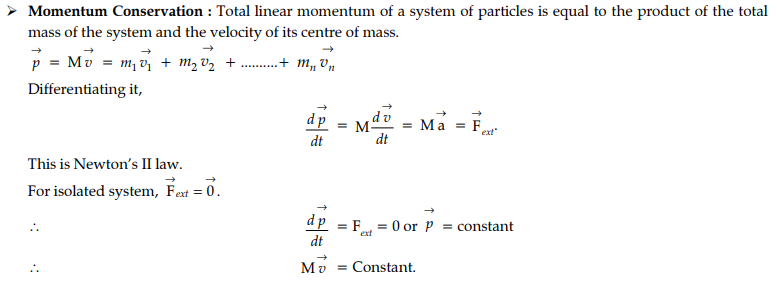Centre Of Mass
\(R_{cm}=\frac {m_1\vec{r_1}+m_2\vec{r_2}+m_3\vec{r_3}+\cdots\cdots +m_n\vec{r_n}} {m_1+m_2+m_3+\cdots+m_n}\)
\(R_{cm}= \frac {\displaystyle \sum_{i=1}^{i=n} m_i \vec{r_i}} {M}\)
where, \(M=\displaystyle \sum_{i=1}^{n} m_i\)
\(\vec{\tau}=\vec{r} \times \vec{F}\)
\(\vec{L}=\vec{r} \times \vec{P}\)
\(L_z=xp_y-yp_x\)
\(L_x=yp_z-zp_y,L_y=zp_x-xp_z\)
\(L=rp\sin \phi\)


Torque And Angular Momentum
\(\vec{\tau}=\frac {d\vec{L}} {dt}\)
\(L_1+L_2+L_3+\cdots\cdots+\vec{L_m}=\text{a constant}\)
\(I=m_1r_1^2+m_2r_2^2+m_3r_3^2+\cdots+m_nr_n^2\)
\(=\displaystyle\sum_{i=1}^{i=n} m_ir_i^2\)
\(K=\sqrt{\frac {r_1^2+r_2^2+r_3^2+\cdots +r_n^2} {n}}\)
\(I_z=I_x+I_y\)


Moment Of Inertia
\(I_z=I_x+I_y\)
\(I=I_c+ Mh^2 \)
\(K_R=\frac {1} {2} I\omega^2\)
\(\tau=I\alpha\)
where \(\alpha=\text{angular acceleration}\)
(i) M.I of a rod about an axis through its c.m. and perpendicular to rod,
\(I=\frac {1} {12}ML^2\)
(ii) M.I of circular ring about an axis through its centre and perpendicular to its plane
\(I=MR^2\)
(iii) M.I of a circular disc about an axis through its centre and perpendicular to its plane
\(I=\frac {1} {12}MR^2\)
(iv) M.I of a right circular solid cylinder about its symmetry axis
\(I=\frac {1} {2}MR^2\)
(v) M.I of a right circular hallow cylinder about its axis= \(MR^2\)
(vi) M.I of a solid sphere about its diameter
\(I=\frac {2} {5}MR^2\)
(vii) M.I of spherical shell about its diameter
\(I=\frac {2} {3}MR^2\)


External Forces
The centre of mass of a system of particles moves as if the entire mass of the system were concentrated at the centre of mass and all the external forces were applied at that point. The velocity of centre of mass of a system of two particles, m1 and m2 with velocity v1 and v2
• If no external force acts on the body, then the centre of mass will have constant momentum. Its velocity is constant and acceleration is zero, i.e., MVcm = constant.


Torque
Torque
Torque is the moment of force. Torque acting on a particle is defined as the product of the magnitude of the force acting on the particle and the perpendicular distance of the application of force from the axis of rotation of the particle.
Angular Momentum
The angular momentum (or moment of momentum) about an axis of rotation is a vector quantity, whose magnitude is equal to the product of the magnitude of momentum and the perpendicular distance of the line of action of momentum from the axis of rotation and its direction is perpendicular to the plane containing the momentum and the perpendicular distance.


Axis Of Rotation
Axis of Rotation
A rigid body is said to be rotating if every point mass that makes it up, describes a circular path of a different radius but the same angular speed. The circular paths of all the point masses have a common centre. A line passing through this common centre is the axis of rotation.
• A rigid body is said to be in equilibrium if under the action of forces/torques, the body remains in its position of rest or of uniform motion.
For translational equilibrium, the vector sum of all the forces acting on a body must be zero. For rotational equilibrium, the vector sum of torques of all the forces acting on that body about the reference point must be zero. For complete equilibrium, both these conditions must be fulfilled.


Rigid Body
Couple
Two equal and opposite forces acting on a body but having different lines of action form a couple. The net force due to a couple is zero, but they exert a torque and produce rotational motion.
• Moment of Inertia
The rotational inertia of a rigid body is referred to as its moment of inertia.
The moment of inertia of a body about an axis is defined as the sum of the products of the masses of the particles constituting the body and the square of their respective perpendicular distance from the axis.


Radius Of Gyration
Radius of Gyration
The distance of a point in a body from the axis of rotation, at which if whole of the mass of the body were supposed to be concentrated, its moment of inertia about the axis of rotation would be the same as that determined by the actual distribution of mass of the body is called radius of gyration.
If we consider that the whole mass of the body is concentrated at a distance K from the axis of rotation, then moment of inertia


The Theorem Of Parallel Axes
The theorem of Parallel Axes
According to this theorem, the moment of inertia I of a body about any axis is equal to its moment of inertia about a parallel axis through center of mass, Icm, plus Ma2 where M is the mass of the body and V is the perpendicular distance between the axes, i.e.,
The theorem of Perpendicular Axes
According to this theorem, the moment of inertia I of the body about a perpendicular axis is equal to the sum of moments of inertia of the body about two axes at right angles to each other in the plane of the body and intersecting at a point where the perpendicular axis passes, i.


Longitudinal Wave Motion
Longitudinal wave motion
In these types of waves, particles of the medium vibrate to and fro about their mean position along the direction of propagation of energy. These are also called pressure waves. Sound waves are longitudinal mechanical waves.
• Wavelength
The distance travelled by the disturbance during the time of one vibration by a medium particle is called the wavelength (λ). In case of a transverse wave the wavelength may also be defined as the distance between two successive crests or troughs. In case of a longitudinal wave, the wavelength (λ) is equal to distance from centre of one compression (or refraction) to another.
• Wave Velocity
Wave velocity is the time rate of propagation of wave motion in the given medium. It is different from particle velocity. Wave velocity depends upon the nature of medium.
Wave velocity (υ) = frequency (v) x wavelength (λ)
• Amplitude
The amplitude of a wave is the maximum displacement of the particles of the medium from their mean position.


 beeTokens
beeTokens 



